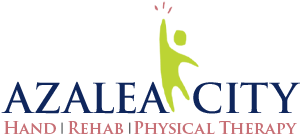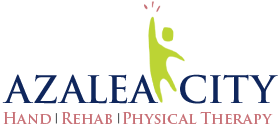Tennis Elbow in Mobile AL

If you're experiencing pain in your elbow that worsens when you grip, lift, or even shake hands, you might be dealing with a condition commonly known as tennis elbow. Despite its name, tennis elbow isn't limited to tennis players; it affects anyone who overuses their arm, hand, or wrist in repetitive activities. This condition can be frustrating, often leading to discomfort that interferes with daily activities. Fortunately, physical therapy/occupational therapy offers a non-invasive, effective approach to relieving tennis elbow pain in Mobile AL and restoring full function to your arm.
Azalea City Hand and Rehab and Physical Therapy can help you understand everything you need to know about tennis elbow, from its causes and symptoms to how physical therapy/occupational therapy can help you recover and prevent future flare-ups.
What Is Tennis Elbow in Mobile AL?
Tennis elbow, or lateral epicondylitis, is a condition characterized by inflammation of the tendons that join the forearm muscles to the outer part of your elbow. These tendons, especially the one connected to the extensor carpi radialis brevis muscle, help you extend your wrist and fingers. When these tendons are overused or strained, microscopic tears can develop, causing pain and inflammation. Over time, this repetitive strain can lead to chronic discomfort if left untreated.
Despite its name, tennis elbow doesn't only affect athletes. Anyone who engages in repetitive arm or wrist motions-whether through work, hobbies, or sports-can develop this condition. Activities like typing, painting, or even cooking can contribute to the development of tennis elbow.
Symptoms of Tennis Elbow In Mobile AL
The symptoms of tennis elbow can range from mild discomfort to severe pain that radiates from the elbow down the forearm. It's important to recognize these symptoms early to avoid worsening the condition. Common signs of tennis elbow include:
- Pain or Burning on the Outside of the Elbow: This is the hallmark symptom of tennis elbow. The pain often worsens with activities that involve gripping, lifting, or twisting motions.
- Weak Grip Strength: As the condition progresses, you may find it difficult to hold objects, shake hands, or even open a jar due to weakness in your forearm muscles.
- Pain When Lifting or Bending Your Arm: Everyday tasks such as lifting grocery bags, holding a cup of coffee, or even brushing your teeth can become painful.
- Stiffness in the Elbow: You might experience stiffness, particularly in the morning or after periods of rest.
- Pain that Radiates Down the Arm: In more severe cases, the pain may extend down your forearm toward your wrist.
If you notice these symptoms, especially if they persist or worsen, it's important to seek help to prevent long-term damage.
What Causes Tennis Elbow?
Tennis elbow is typically caused by overuse and repetitive motion, particularly those involving gripping, twisting, or lifting. The tendons around the elbow become strained and eventually develop small tears that lead to pain and inflammation. Here are some of the most common causes of tennis elbow:
- Repetitive Activities: Tennis elbow is commonly associated with activities that require repetitive hand and wrist motions. Sports like tennis, golf, or racquetball are known culprits, but other activities like typing, carpentry, and even gardening can also lead to this condition.
- Improper Technique: Athletes, particularly tennis players, may develop tennis elbow due to improper form or using the wrong equipment. For example, a tennis racket that's too heavy or held with a poor grip can put excessive strain on the tendons.
- Age-Related Degeneration: As we age, our tendons naturally become less elastic and more prone to injury. People between the ages of 30 and 50 are at a higher risk of developing tennis elbow, especially if they engage in repetitive arm activities.
- Occupational Hazards: Certain jobs, such as construction work, painting, or even cooking, can increase the risk of tennis elbow due to the repetitive use of hand tools, wrist movements, or lifting.
Understanding the causes of tennis elbow is key to both treating and preventing the condition, making early intervention essential.
How Is Tennis Elbow Diagnosed?
If you suspect you have tennis elbow, your healthcare provider will start with a thorough evaluation of your symptoms, medical history, and activity level. Here are the common steps involved in diagnosing tennis elbow:
- Physical Examination: Your doctor or physical therapist will examine your arm, elbow, and wrist, looking for areas of tenderness, swelling, or weakness. They may ask you to move your arm in certain ways or apply pressure to the area to assess the extent of your pain.
- Pain and Strength Tests: You may be asked to grip an object or extend your wrist and fingers while your doctor applies resistance. These tests help determine the strength of your muscles and the severity of your discomfort.
- Imaging Tests: In some cases, an X-ray or MRI may be ordered to rule out other conditions such as arthritis, fractures, or nerve damage. While these imaging tests aren't always necessary, they can provide a clearer picture of the extent of your injury.
Once tennis elbow is diagnosed, the next step is developing an appropriate treatment plan-this is where physical therapy/occupational therapy plays a crucial role.
How Physical Therapy/Occupational Therapy Helps People with Tennis Elbow
Physical therapy/occupational therapy is an essential part of the treatment plan for tennis elbow, offering both pain relief and a long-term solution to prevent recurrence. By addressing the root cause of the problem, physical therapy/occupational therapy helps you regain strength, improve flexibility, and return to your daily activities pain-free. Here's how physical therapy/occupational therapy can help:
1. Pain Management
One of the first goals of physical therapy/occupational therapy is to reduce the pain and inflammation caused by tennis elbow. Your physical therapist will use various techniques to help manage your discomfort:
- Manual Therapy: Hands-on manipulation of the affected tendons and muscles can help relieve tension, increase blood flow, and reduce pain.
- Ice or Heat Therapy: Applying ice can help decrease inflammation and numb the area, while heat can relax muscles and improve circulation.
- Electrical Stimulation: This treatment uses mild electrical currents to reduce pain and promote healing by stimulating the muscles and tissues.
2. Strengthening and Stretching Exercises
Strengthening and stretching exercises are crucial for restoring the function of your elbow and forearm muscles. These exercises target both the extensor muscles (which are often weak in tennis elbow) and the flexor muscles to provide balanced support.
- Strengthening Exercises: Your physical therapist will guide you through exercises that build strength in the muscles of your forearm, wrist, and elbow. Strengthening these muscles helps reduce the strain on the tendons and prevent future injury.
- Stretching Exercises: Stretching is essential to improve flexibility and reduce muscle tightness. Stretching the forearm and wrist muscles can relieve tension and allow for smoother movement.
3. Improving Your Technique
If your tennis elbow was caused by poor technique in a sport or activity, physical therapy/occupational therapy includes training on proper form. Whether you're a tennis player or someone who uses hand tools regularly, your therapist will help you adjust your technique to reduce strain on the tendons.
- Ergonomic Advice: If your job involves repetitive hand or wrist movements, your therapist will recommend adjustments to your work setup or the way you perform certain tasks. Simple changes, such as adjusting the height of your workstation or using proper hand tools, can significantly reduce the risk of future injury.
- Sports Technique Training: For athletes, improving your form-such as adjusting your grip or using the right equipment-can make all the difference. Your therapist will work with you to refine your technique, reducing strain on your elbow and improving performance.
4. Long-Term Prevention Strategies
Physical therapy/occupational therapy not only treats your current tennis elbow but also helps prevent future flare-ups. By building strength, improving flexibility, and learning proper body mechanics, you'll be better equipped to avoid re-injury. Your therapist will provide you with exercises you can do at home to maintain your progress and keep your muscles healthy and strong.
What Should You Do If You Think You Have Tennis Elbow?
If you're experiencing symptoms of tennis elbow, early intervention is key to a speedy recovery. Here's what you should do:
- Rest and Avoid Overuse: The first step is to give your elbow a break from the activities that may have caused the condition. Avoid repetitive motions and heavy lifting until you've been evaluated by a healthcare professional.
- Apply Ice: To reduce inflammation, apply ice to the affected area for 15-20 minutes several times a day.
- Consult a Physical Therapist: Don't wait until the pain becomes unbearable. A physical therapist can help you develop a personalized treatment plan that addresses your symptoms and helps you recover faster.
- Strengthen and Stretch: Once diagnosed, you'll be guided through exercises that will strengthen the muscles around your elbow and stretch tight tendons, ensuring long-term recovery and prevention.
Find Relief From Your Tennis Elbow With Physical Therapy/Occupational Therapy
Tennis elbow may be a common condition, but it doesn't have to take over your life. With the right treatment, you can recover fully and prevent future flare-ups. Physical therapy/occupational therapy at Azalea City Hand and Rehab and Physical Therapy in Mobile AL offers a comprehensive, non-invasive approach to managing tennis elbow, focusing on pain relief, strengthening, and long-term prevention. If you're experiencing elbow pain or weakness, don't wait-schedule an appointment with a physical therapist today and take the first step toward a pain-free life.
OFFICE HOURS
Monday
8:00am - 5:00pm
Tuesday
8:00am - 5:00pm
Wednesday
8:00am - 5:00pm
Thursday
8:00am - 5:00pm
Friday
8:00am - 12:00pm
Saturday & Sunday
Closed
Azalea City Hand and Rehab and Physical Therapy
316 S Sage Ave Ste C
Mobile, AL 36606


